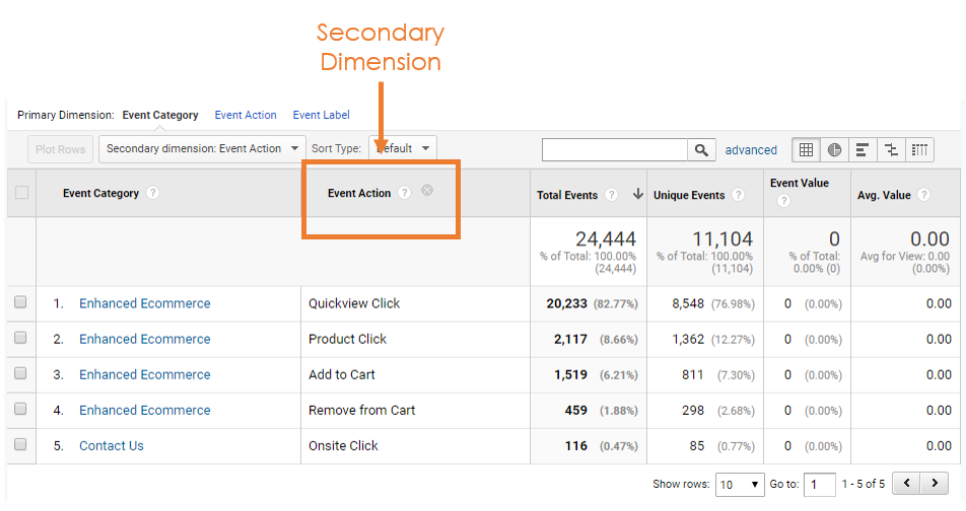Optimizing Data Analysis: Google Analytics Secondary Dimension Explained
Wiki Article
Opening the Power of Second Measurement Analytics for Improved Data Insights and Decision-Making
In the realm of data analytics, main dimensions commonly take the limelight, however the real depth of understandings lies within the realm of secondary measurements. By using the power of second dimension analytics, companies can unveil covert trends, uncover correlations, and remove extra purposeful conclusions from their data.
Significance of Second Measurements
Exploring the value of additional measurements in analytics unveils the hidden layers of data insights vital for educated decision-making in various domains. Additional dimensions provide a much deeper understanding of main information by providing extra context and perspectives. By incorporating second dimensions into analytics, organizations can draw out a lot more detailed and nuanced insights from their datasets.One trick significance of secondary measurements is their capacity to sector and categorize main data, permitting a much more comprehensive analysis of details subsets within a dataset. This division enables organizations to identify patterns, fads, and outliers that might not appear when checking out the information as a whole. In addition, second dimensions assist in uncovering connections and reliances in between various variables, leading to more precise projecting and anticipating modeling.
Additionally, secondary dimensions play a critical function in enhancing information visualization and reporting. By including secondary dimensions to visualizations, such as charts or graphes, analysts can produce a lot more informative and informative representations of data, assisting in far better communication of searchings for to stakeholders. In general, the integration of second dimensions in analytics is critical in opening the complete capacity of data and driving evidence-based decision-making.
Secret Benefits of Making Use Of Secondary Measurements
Using secondary dimensions in analytics uses organizations a strategic advantage by augmenting the deepness and granularity of data insights. By studying information using additional measurements such as time, area, gadget kind, or individual demographics, companies can uncover patterns, fads, and correlations that may otherwise remain hidden.Moreover, the application of additional dimensions boosts the context in which main data is interpreted. It provides a much more comprehensive view of the relationships between various variables, allowing companies to make educated choices based upon an extra alternative understanding of their information. Additionally, second measurements assist in the identification of outliers, anomalies, and areas for optimization, ultimately resulting in much more effective strategies and enhanced results. By leveraging second measurements in analytics, companies can harness the full capacity of their data to drive better decision-making and attain their service purposes.
Advanced Information Analysis Techniques
A deep study innovative data analysis techniques discloses advanced approaches for removing beneficial understandings from complex datasets. One such strategy is artificial intelligence, where formulas are employed to identify patterns within information, predict outcomes, and make data-driven choices. This method permits the automation of analytical model building, making it possible for the handling of huge quantities of data at a much faster speed than typical techniques.An additional innovative technique is anticipating analytics, which utilizes statistical formulas and artificial intelligence techniques to forecast future end results based upon historical data. By examining patterns and trends, businesses can expect consumer behavior, market fads, and possible threats, equipping them to make aggressive decisions.
Moreover, text mining and sentiment analysis are beneficial methods for removing understandings from disorganized information sources such as social media comments, client reviews, and study feedbacks. By examining text information, organizations can understand customer viewpoints, identify arising trends, and enhance their services or products based upon feedback.
Enhancing Decision-Making Via Additional Dimensions

Enhancing decision-making via secondary dimensions allows services to make even more notified and targeted strategic selections. By segmenting customer information based on secondary dimensions like purchasing background or engagement levels, business can customize their marketing approaches to certain audience sections, leading to improved conversion prices and consumer satisfaction. In addition, second dimensions can help recognize correlations and connections in between various variables, allowing companies to make data-driven decisions that drive development and earnings.
Executing Second Measurement Analytics
When integrating secondary measurements in analytics, companies can open much deeper insights that drive tactical decision-making and improve overall performance. Executing second measurement analytics requires an organized method to make certain reliable utilization of this powerful tool. The initial step is to determine the key metrics and dimensions that straighten with the company's calculated objectives. This involves recognizing the particular concerns the company seeks to respond to and the data factors called for to resolve them.
Furthermore, organizations should leverage progressed analytics tools and modern technologies to improve the procedure of integrating second measurements. These devices can automate information processing, evaluation, and visualization, allowing companies to concentrate on analyzing understandings as opposed to hand-operated information control.
Verdict
In conclusion, secondary measurement analytics play an important function in enhancing data insights and decision-making processes. By utilizing advanced information analysis strategies and executing second dimensions properly, companies can unlock the power of their information to drive calculated business decisions. The key benefits of using secondary measurements can not be overstated, as they provide a deeper understanding of data fads and relationships. It is necessary for companies to leverage secondary measurement analytics to remain affordable in today's data-driven landscape.In the realm of data analytics, main measurements commonly take the limelight, however the real depth of insights lies within the world of secondary measurements.Using secondary investigate this site dimensions in analytics uses organizations a strategic advantage by augmenting the deepness and granularity of data understandings. By leveraging secondary measurements in analytics, companies can harness the complete possibility of their information to drive much better decision-making and attain their business objectives.
Implementing data validation procedures and normal audits can aid maintain information high quality and reliability.
By using innovative information evaluation Go Here techniques and carrying out additional dimensions successfully, organizations can unlock the power of their information to drive calculated service choices.
Report this wiki page